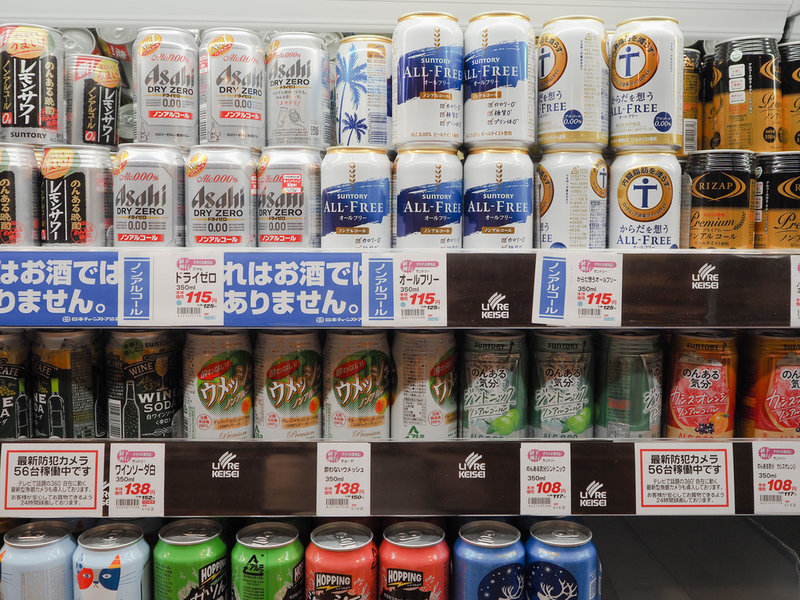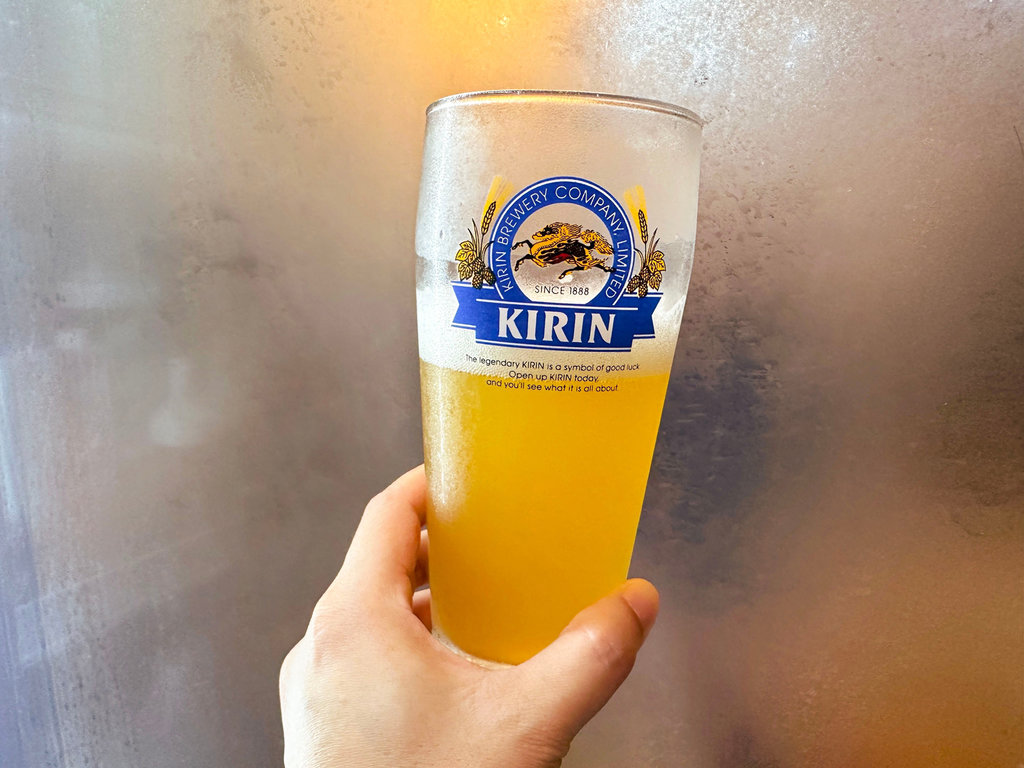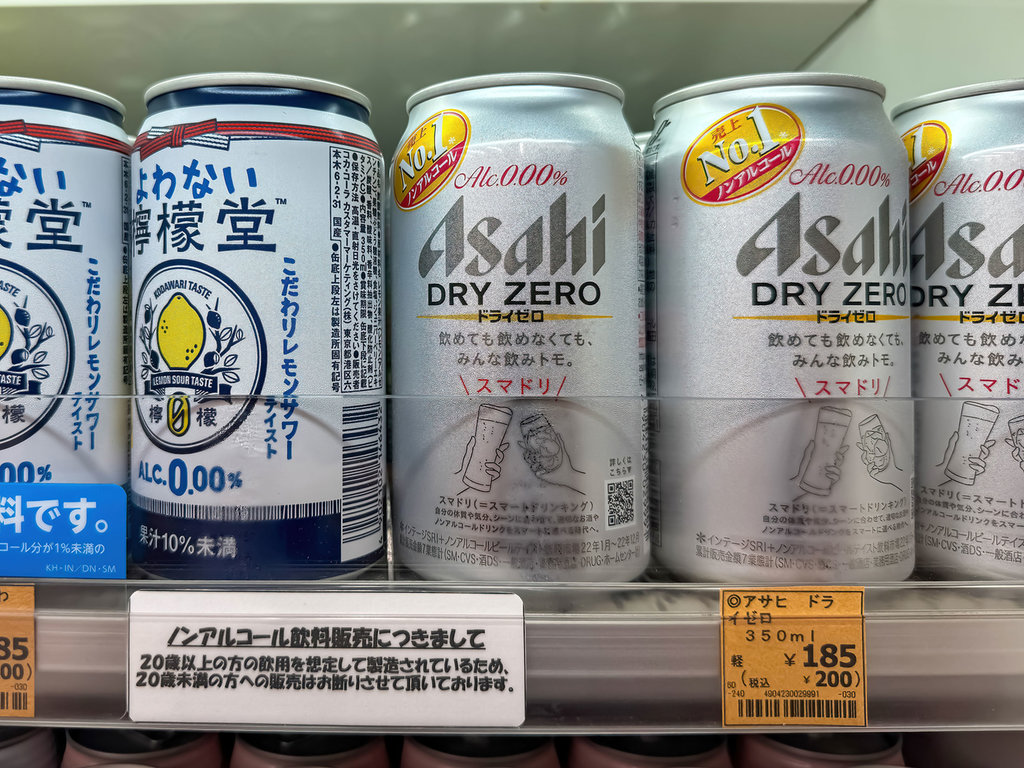Feature
Japan’s brewers have home advantage in alcohol-free
Japan has the second-largest consumption of non-alcoholic beer worldwide. Fiona Holland explores whether foreign brands stand a chance in a trade dominated by local giants.

Cans of non-alcoholic beer on sale in Chiba, Japan. Credit: Ned Snowman / Shutterstock.com
Out of all the alternatives to alcohol, non-alcoholic beer has so far made the greatest inroads.
Whether it’s the rise of specialists like Athletic Brewing in the US or Big Drop in the UK, or the march of multinationals like Heineken or Asahi into the sector, alcohol-free beer, while still small, is eating into the sales of conventional brews in North America and western Europe.
Yet, after Germany, the largest market for non-alcoholic beer is Japan. According to findings from GlobalData, Just Drinks’ parent, Japan consumed more than 3m hectolitres in 2023, representing growth of more than 20% since 2018 (that compares to 47.7m hectolitres of beer last year).
The leading brands in Japan’s non-alcoholic beer market are owned by the local brewing giants – Asahi, Kirin, Sapporo and Suntory. They have been producing non-alcoholic beer alternatives long before the category made headway in the West. Kirin launched its first 0.0% beer-flavoured beverage Kirin Free in 2009 and Suntory’s All-Free hit shelves in 2010, Sapporo released Sapporo Premium Alcohol Free in 2011.
The growth of non-alcoholic beer in Japan comes against the backdrop of declining alcohol consumption in the country. GlobalData research shows that, between 2019 and 2023, beer and cider intake consumption nearly 12%. In 2021, the fall in demand even pushed Japan’s National Tax Agency to launch the Sake Viva! Campaign, where 20- to 39-year-olds were tasked with developing ideas to increase drinking among young consumers.
As global alcohol-free brands look for new markets, Japan appears enticing. In October, Heineken became the first foreign brand to launch its 0.0% product in the country, calling it “the next step in the company’s progress”. But, if Japan appears to hold such potential, why haven’t more overseas non-alc beer brands set up shop?
Japan’s potential on paper
Despite Japanese brewers having a stronghold in the market, there are several reasons as to why foreign non-alcoholic beer brands might see potential in selling in the country.
“[Since] just before the pandemic, I think the interest in Japan has been on the increase”, says Ken Masuno, account manager at Tokyoesque, a London and Amsterdam-based market research group set up in 2014 that helps European and Japanese companies enter each other’s markets.
“For retail products, China and Japan has typically always been the main obvious choice”, he adds. “However, the political risks that come with exposure in China I think has [forced Western] companies to look to Japan as the gateway to Asia.”

Credit: maruco / Shutterstock.com
The country’s development as a holiday destination is also expected to drive an increase in the consumption of non-alcoholic drinks. “If you look at Japan today, they’re expecting around 30m tourists [to visit] in a year”, Masuno explains. Out of that figure, a majority will come from South Korea, Taiwan and South East Asian countries like Thailand, Indonesia, and Malaysia, he says. “Indonesia and Malaysia for example are [majority] Muslim nations so non-alcoholic beverages are obvious [choices] here.”
In most markets in Asia, alcohol-free beer as a concept is quite alien.
Kevin Baker, GlobalData
Japan’s focus on growing its alcohol-free sector is also unique in the Asian market. As Kevin Baker, head of global beer & cider research at GlobalData explains, “you haven’t even got other Asian regional brewers like San Miguel having a significant share in that market. It’s unusual in having quite a large alcohol-free market. [In] most markets in Asia the concept is somewhat alien.”
The statistics speak for themselves. Japan far outweighs other Asian countries when it comes to volumes, with the second largest market for non-alcoholic beer production being China which hit just 235,340 hectolitres in 2023.
Unlike other markets in Asia, Japan’s focus on non-alcoholic beer is helped because of the heritage of brewing that’s attached to the leading companies, adds Baker. Consequently, the country “behaves a lot more like a European market, and much less like an Asian market”, he says.
The performance of local brands
Despite rising consumption, some Japanese brands have reported slight dips in growth. Back in 2020, Kirin predicted its non-alcoholic beer unit would grow nearly twofold between 2019 and 2023. “Kirin’s non-alcoholic business is shrinking somewhat”, Kengo Magi, senior manager of marketing at Kirin Brewery, concedes, “influenced by competitors more aggressively increasing the number of products.”
Suntory’s experience is similar. A company spokesperson said sales of its All-Free non-alcoholic-beer brand fell 1% year-on-year to 8.4m cases.
However, the spokesperson said Suntory has still seen growth from the brand of more than 14% versus 2019. The spokesperson adds: “The sales volume of our non-alcoholic beer category takes just over 10% of our alcoholic beer category, so we believe there is still room for us to expand the demand.”
Health fuelling demand and NPD
One trend contributing to the demand for non-alcoholic beer in Japan is the growing interest in added health benefits in beverages. The consumer interest in functional or ‘better-for-you’ qualities in drinks is “equally present in Japan as they are everywhere else,” Baker says, “with people wanting to cut down alcohol consumption [and] looking at their health and understanding the health-giving quality of hops. That’s a new category that’s emerging.”
Just a handful of brands have entered the functional space in non-alcoholic beer in the West. UK-based Fungtn, for example, produces alcohol-free lagers and IPAs with functional mushrooms-based at the centre of their recipes. In Belgium, Thrive’s non-alcoholic blondes contain protein and vitamins B and D.

Credit: Jirapan switch / Shutterstock.com
This part of the market is also in its early stages in Japan but big drinks groups are showing interest. One of Suntory’s most successful non-alcoholic beer brands in the country, according to GlobalData consumption figures, is its All-Free Ashita-wo-Omomo (meaning “thinking of tomorrow” in Japanese), which claims to be good for memory. Kirin’s Karada Free also carries health claims of helping to reduce levels of visceral fat in the body, while Asahi Healthy Style is marketed as a “beer-taste drink” that “moderates the rise in blood triglyceride levels after meals.”
While the functional focus is still a niche globally, it could prove a useful selling point for businesses considering a future in Japan’s non-alcoholic beer market.
Navigating the category
In many respects, Japan stands out as an ideal place for a non-alcoholic beer business brewer to expand into Asia. That said, the country isn’t the easiest market for international brands to navigate.
One significant difference is, in Japan, non-alcoholic beer is not described as ‘beer’ but a ‘beer-like beverage’.
“Specifically in Japan, you have this issue that they can’t call it beer,” Baker explains. “By law… beer has a definition, and the definition says it’s an alcoholic product made from the brewing of malt.” Suntory All-Free for example is described as ‘sparkling malt and hops beverage’.
Japanese consumers are still very price conscious.
Jeanie Chen, Morningstar
Another contrast with Western markets is the one-month focused campaigns around abstaining from alcohol like Dry January or Sober October. These don’t play a role in marketing strategies for non-alcoholic beverages in Japan, says Jeanie Chen, senior analyst at financial services group Morningstar.
Premiumisation has also yet to shape consumption trends to the same degree, she says. “This trend of ‘drink less, drink better’ is not as popular in Japan as a lot of the Western market. Japanese consumers are still very price conscious.”
Heineken’s entrance
Heineken was one of the first foreign companies to launch a 0% version of its alcoholic beer in Japan in October. While “still in its early stages”, the brand has received “largely positive” reviews so far, insists Tony Wheeler, general manager at Heineken Japan.
Wheeler concedes the Dutch brewing giant has faced some challenges with supply, specifically relating to “low distribution… in supermarkets and convenience stores” due to a lack of shelf space that could accommodate the size of the Heineken 0% can. This has forced the company to develop “an additional packaging of standard-sized cans this April exclusively for [convenience store] chains”, Wheeler says.
Baker says Heineken has been “battling against” the market. “The local brewers are so entrenched in terms of distribution networks, shelf space, bar space”, he explains. “Japanese consumers tend to go with Japanese brands by and large. It would be a tricky market for anyone to get into.”

Credit: Maryia_K / Shutterstock.com
Heineken is confident consumer interest in Japan in “a healthier lifestyle” will support the growth of its non-alcoholic brand in the country. “Ultimately, the trend amongst Japanese consumers is to seek healthier lifestyles and adopt moderate levels of alcohol consumption, which will work to the benefit of Heineken 0.0’s expansion in Japan”, Wheeler says.
Independent brands
While smaller non-alcoholic beer brands have done carved out footholds in markets in North America and Europe, analysts don’t expect them to see a similar reception in Japan.
“There are craft brewers there but it hasn’t taken off the way it has in other markets”, explains Baker. “If you think of someone like Big Drop, or Athletic Brewing and Lucky Saint… There’s a lot of companies of the sort in Europe and the US that have done well coming from that small entrepreneurial craft beer space. That’s very unlikely to play in Japan because it’s a very small space.”
Chen echoes Baker’s sentiments. “Craft beer is not really popular in Japan”, she says. “The volume remains below 2% and it’s partly because the Japanese [alcoholic] beer has a very high quality, so the difference between craft and the regular mainstream beers is not so big. People are not willing to pay a big premium… for craft.”
Branding approach
Another factor to consider is not all local brands are developing alcohol-free versions of their bestselling beers. For example, Kirin’s marketing strategy for non-alcoholic beer is focused on establishing stand-alone alcohol-free brands.
As Magi explains, the brewer’s approach “is characterised by the fact that we are nurturing our own non-alcoholic brands at the core, rather than brands that are based on endorsement of existing beer in the Japanese market”.
On the other hand, Asahi is partly focused on developing non-alcoholic versions of its alcoholic beers, such as Asahi Dry Zero, which promotes the same ‘dry’ finish as its alcoholic Super Dry brand.

Credit oasisamuel / Shutterstock.com
Since 2021 in Japan, it has also been building a new category of 0.5% beers and improving its 0.0% selection, using a similar production process as alcohol-free beer manufacturers in the West, where the alcohol is removed after brewing.
Commenting on the success of Asahi’s non-alcoholic portfolio (this includes four non-alcoholic beer products and one non-alcoholic RTD), Mizuho Kajiura, head of marketing at Asahi Breweries, says the company expects “the position” of its low-and-no products to “[continue] to rise in the future.”
He adds the company “achieved a record-breaking Y42.8bn ($289m) in sales from its non-alcohol beverages in Japan” in 2023, representing “a substantial increase of approximately 70%”.
When it comes to the company’s non-alcoholic beer segment and specifically its 0.5% products however, some analysts argue that the product is not gaining momentum. Chen, who works with Asahi, argues “the product hasn’t really gained much traction with consumers yet.”
Partnership potential
Even if sales from certain brands are patchy, what Asahi and its Japanese peers benefit from is the fact they can make money from a varied portfolio.
The key is to find the right partner for the market.
Ken Masuno, Tokyoesque
As Masuno at Tokyoesque explains: “Asahi, Suntory, Kirin, from tea to alcoholic beverages to non-alcoholic, they cover everything. As long as they can provide what the audience is demanding, they can still benefit from it.
“That’s a huge difference compared to the Western market, and I think that makes it easier for the companies to commit [to alcohol-free beer].”
If an overseas non-alcoholic beer brand is serious about tackling Japan, it seems that being a well-established brand is essential. “Heineken 0% tends to do well in all markets [because] it rides on the coattails of the parent Heineken brand. Heineken is known for quality, and it is widely recognised,” Baker says. A company’s “credentials” and “international brand recognition” are crucial, he adds.
But, in addition to having an established name, businesses need to prepare for partnerships. “The key is to find the right partner for the market,” Masuno says. “In Japan, there are already [local] established companies who are willing to go into a partnership and already have the distribution lines. They know the market inside out.”
Matching up with a major Japanese drinks company might not be a suitable option for every business, especially if they already have an international presence. Regardless of that fact, Masuno stresses: “It’s a balance [and] you have to consider what is most important. If you want to open the gate to Asia, you might have to give up something of your own pride.”